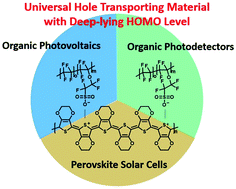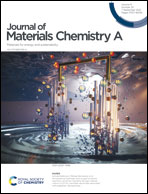Perfluorinated ionomer and poly(3,4-ethylenedioxythiophene) colloid as a hole transporting layer for optoelectronic devices†
Abstract
A polymer-based hole-transporting layer (HTL) with a tunable work function and highest occupied molecular orbital (HOMO) position was demonstrated to effectively optimize the anode junctions of optoelectronic devices. Herein, the perfluorinated ionomer (PFI) was utilized to realize the synthesis of a well-dispersed poly(3,4-ethylene dioxythiophene) (PEDOT) colloid solution, which could be subsequently cast into an efficient HTL. According to the time-of-flight secondary-ion mass spectroscopy and ultraviolet photoelectron spectroscopy analysis, a uniform, interpenetrating PEDOT network with a deep-lying HOMO position could be obtained in the PEDOT:PFI layer. For solar cells, since a deep-lying HOMO position of the HTL was favorable for minimizing the hole injection barrier, a superior organic photovoltaic efficiency of 15.1% and a perovskite solar cell efficiency of 17.8% were achieved. As for organic photodetectors, a deep-lying HOMO position of the HTL was able to reduce the dark current density (JD) by blocking the leakage current under a reverse bias. Utilizing the PEDOT:PFI with an optimized PFI content, an extremely low JD of 6.2 nA cm−2 with an external quantum efficiency of 67% at 1000 nm wavelength was achieved, which sets a benchmark for the emerging near infrared sensing technologies.



 Please wait while we load your content...
Please wait while we load your content...